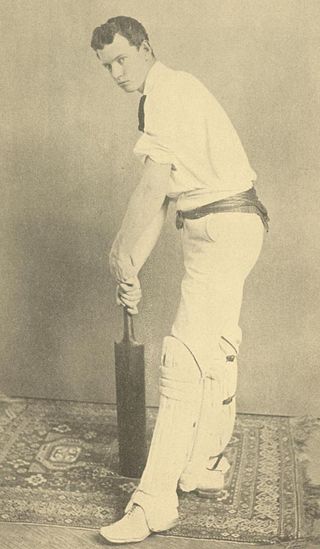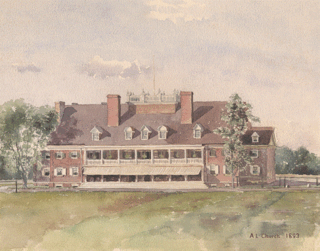First-class cricket, along with List A cricket and Twenty20 cricket, is one of the highest-standard forms of cricket. A first-class match is one of three or more days' scheduled duration between two sides of eleven players each and is officially adjudged to be worthy of the status by virtue of the standard of the competing teams. Matches must allow for the teams to play two innings each, although in practice a team might play only one innings or none at all.

John Barton "Bart" King was an American cricketer, active in the late 19th and early 20th centuries. King was part of the Philadelphia team that played from the end of the 19th century until the outbreak of World War I. This period of cricket in the United States was dominated by "gentlemen cricketers"—men of independent wealth who did not need to work. King, an amateur from a middle-class family, was able to devote time to cricket thanks to a job set up by his teammates.

The United States men's national cricket team is the team that represents the United States in international cricket. The team was formerly organized by the United States of America Cricket Association (USACA), which became an associate member of the International Cricket Council (ICC) in 1965. In June 2017, the USACA was expelled by the ICC due to governance and financing issues, with the U.S. team being temporarily overseen by ICC Americas until a new sanctioning body was established. In January 2019, associate membership was officially granted to USA Cricket.
The Association of Cricket Statisticians and Historians (ACS) was founded in England in 1973 for the purpose of researching and collating information about the history and statistics of cricket. Originally called the Association of Cricket Statisticians, the words "and Historians" were added in 1992 but it has continued to use the initialism ACS.

The Philadelphian cricket team was a team that represented Philadelphia, Pennsylvania, in first-class cricket between 1878 and 1913. Even with the United States having played the first ever international cricket match against Canada in 1844, the sport began a slow decline in the U.S. This decline was furthered by the rise in popularity of baseball. In Philadelphia, however, the sport remained very popular and from the end of the 19th century until the outbreak of World War I, the city produced a first class team that rivaled many others in the world. The team was composed of players from the four chief cricket clubs in Philadelphia–Germantown, Merion, Belmont, and Philadelphia. Players from smaller clubs, such as Tioga and Moorestown Cricket Club, and local colleges, such as Haverford and Penn, also played for the Philadelphians. Over its 35 years, the team played in 88 first-class cricket matches. Of those, 29 were won, 45 were lost, 13 were drawn and one game was abandoned before completion.
The 1915 to 1918 English cricket seasons were all but wiped out by the First World War.

William Price Newhall was an American cricketer. He played seven first-class matches between 1908 and 1913. Six of these were for the Philadelphian cricket team and the other was for a combined Canada/USA team. Newhall comes from a cricketing family, as his father and four uncles all played first-class cricket, and several other members of the family also played at a lower level. On at least one occasion, they made up all the members of a team.
The history of United States cricket begins in the 18th century. The first game was between the USA and Canada and held in 1844 in front of an audience of 5,000 spectators in New York. Among early Americans, cricket was as popular a bat and ball game as baseball. Though Americans never played cricket in great numbers, the game grew for some time. Around the time of the United States Civil War, the game began competing with baseball for participants, but then slowly declined in popularity. This was followed again by a brief golden age with the Philadelphian cricket team. This lasted until roughly the start of World War I; at this time, cricket again became less popular. In the latter part of the 20th century immigrants from cricket-playing nations in South Asia and the West Indies helped spark a resurgence in the game's popularity. This led to participation and success in several International Cricket Council events. In 2007, the United States of America Cricket Association was suspended by the ICC because of problems with its administration, but was again recognized beginning in 2008.

The Belmont Cricket Club was one of four chief cricket clubs in Philadelphia, Pennsylvania, that played from its 1874 founding in West Philadelphia until its disbanding in 1914. Bart King, arguably America's greatest cricketer during its 1890-1914 golden age, played for Belmont from 1893 to 1913. Another famous American cricketer, English-born Cecil Hurditch, played for Belmont in 1912 after he returned from playing for the Santa Monica Cricket Club in southern California. In 1913, Hurditch introduced soccer to the club members.

George Stuart Patterson was an American cricketer, active in the late 19th century. Patterson played most notably for the Philadelphians, which flourished from the end of the 19th century until the outbreak of World War I. His obituary in Wisden Cricketers' Almanack described him as "one of the best all-round cricketers ever produced by America." He had a successful career with both Haverford College and the University of Pennsylvania and began playing first-class cricket when he was only 16 years old.
The Tioga Cricket Club was a cricket club in Philadelphia, Pennsylvania, United States. The club played their home matches at the self-titled "Tioga Cricket Club Ground", based on Westmoreland Street in Tioga, Philadelphia. Their first recorded match was in 1887, and in 1890, they joined the Halifax Cup, a formal tournament between a number of cricket clubs in the Philadelphia region. The club was the initial home of Bart King, who was described in his Wisden Cricketers' Almanack obituary as "beyond question the greatest all-round cricketer produced by America." Along with the other teams in the area, Tioga contributed players to the Philadelphian cricket team, who played a number of first-class cricket matches against English opposition. The club disbanded following the 1896 season.

The Germantown Cricket Club is a cricket club in the Germantown neighborhood of Philadelphia, Pennsylvania. It was one of the four principal cricket clubs in the city and was one of the clubs contributing members to the Philadelphian cricket team. It was founded on August 10, 1854 in what is now the northwest section of the city, and is the nation's second oldest cricket club. Its clubhouse was designed by architects McKim, Mead & White. The U.S. National tennis championship, precursor to today's US Open, was played on Germantown Cricket's lawn tennis courts from 1921 to 1923.

John Borland Thayer II was an American businessman who had a thirty-year career as an executive with the Pennsylvania Railroad Company. He was a director and second vice-president of the company when he died at age 49 in the sinking of the RMS Titanic, on April 15, 1912. In his youth, Thayer was also a prominent sportsman, playing baseball and lacrosse for the University of Pennsylvania and first-class cricket for the Philadelphian cricket team.

George Freeman was an English first-class cricketer. He made 32 appearances for Yorkshire County Cricket Club from 1865 to 1880. He also played four matches of first-class cricket for the "United England Eleven" (1866–1869), three games for the "North of England" (1867–1869), four for the "United North of England Eleven" (1870) plus one for the "Players" (1871).
The Young America Cricket Club (YACC) was founded on 19 November 1855 at the house of William Wister after the Germantown Cricket Club team refused to allow young players to gain cricket experience through match participation. Owen Wister, the nephew of William, wrote what is considered the first true Western novel ever written, The Virginian, the prototype for the first movie Western which came out as a silent movie in 1914 and has been filmed many times since that time.
The Wednesday Cricket Club, founded in 1820, became one of the pre-eminent cricket clubs in the Sheffield area. It was the direct forerunner of Sheffield Wednesday Football Club. It was reformed in 2011 and has risen from Section 7 in the Mansfield District League to Section 2 in 2017. Its midweek side play in Division A of the Sheffield Alliance Midweek League in 2018 having won Division B in 2017.

Cricket in the United States is a sport played at the amateur, club, intercollegiate and international competition levels with little popularity, with 200,000 players across the country. Major League Cricket is the highest level of domestic T20 cricket currently played in America, with T20 being the format of the game that much of the recent growth in American cricket is occurring in.
Edward Walter Clark was a Philadelphia businessman and banker who was also noted as a first-class cricketer, yachtsman, and a breeder of cocker spaniels.
Sir James Reginald Conyers CBE was a Bermudian lawyer, politician, and cricketer. Born in Pembroke Parish, Bermuda, Conyers was a keen member of the Hamilton Cricket Club, and toured the United States with the club in 1905. Having regularly played for Bermuda against touring American teams, he was invited to play for the Gentlemen of Philadelphia during the team's 1908–09 tour of Jamaica. In the final match of the tour, against Jamaica at Melbourne Park, Conyers scored 149 runs opening Philadelphia's batting, his highest first-class score and only first-class century. He would later make several appearances for Philadelphia's Merion Cricket Club in the Halifax Cup competition in 1909 and 1911. Conyers remained heavily involved in Bermudian cricket after the tour's end, often captaining the Bermudan national team against touring sides from North America. He was playing competitive cricket until as late as 1928, when he captained Bermuda on a tour of the United States aged 49.
Edward James Sanders was an English first-class cricketer.










